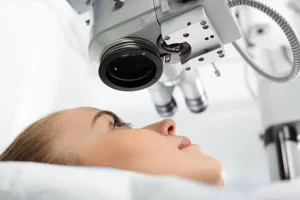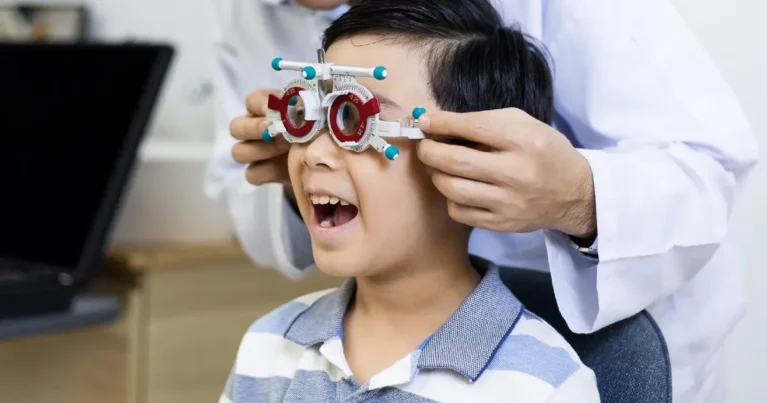Ever felt like your eyes are playing a game of hide-and-seek, each one going its own way? It’s frustrating, right? Those moments when you want to look someone in the eye, but your eyes have different plans. We get it – the discomfort, the headaches, the self-consciousness. But what if we told you there’s a way to turn this eye escapade into a clear, confident gaze? Welcome to the world of squint surgery, where your eyes find their way back home, aligned and ready to take on the world. In this blog, we’ll discover the benefits of squint surgery. So, if you’ve ever wished for a solution to the squint struggle, you’re in the right place.
Contents
Is Surgery Good for Squint Eye?
 Ever wondered if surgery is the right move for a squinting eye? Let’s break it down in simple terms.
Ever wondered if surgery is the right move for a squinting eye? Let’s break it down in simple terms.
Why Surgery?
- When Other Roads Don’t Lead to Clear Vision: Sometimes, exercises or glasses may not be enough to get those eyes in sync. Surgery steps in when other paths don’t quite do the trick.
- A Permanent Fix: Surgery isn’t just a quick fix; it’s a lasting one. If you’re looking for a solution that sticks around, squint surgery is the superhero of eye alignment.
When Surgery Steps In:
- Persistent Struggle: If the squint is causing persistent eye strain, headaches, or trouble focusing, surgery becomes a strong contender to bring lasting relief.
- Amblyopia Concerns: When there’s a risk of amblyopia (that’s when one eye doesn’t see well because the brain is playing favorites), surgery can be a game-changer, reducing the risk significantly.
Remember: Surgery isn’t the first stop; it’s the solution when the journey to clear vision needs an extra push. If you’re in a squint tangle and other fixes aren’t quite cutting it, surgery might just be your ticket to eyes that align and a world that comes into crystal-clear focus.
How is Squint Eye Corrected?
 Correcting a squint, also known as strabismus, involves a few key steps designed to bring those wandering eyes back on the same path.
Correcting a squint, also known as strabismus, involves a few key steps designed to bring those wandering eyes back on the same path.
1. Diagnosis and Assessment:
- Eye Examination: The journey begins with a thorough eye examination. Specialists assess how both eyes are working together and identify the extent of misalignment.
- Vision Testing: Understanding the visual acuity of each eye helps determine the best course of action.
2. Surgical Intervention:
- When Is Surgery Considered? If non-surgical methods don’t provide the desired results or if there’s a risk of complications like amblyopia, surgery becomes a viable option.
- Surgical Procedure: During squint surgery, the eye muscles are adjusted to ensure both eyes work together harmoniously. The procedure aims to achieve optimal alignment and improve overall eye coordination.
3. Post-Operative Care:
- Recovery: After surgery, a recovery period is essential. The eyes need time to adjust, and any discomfort typically subsides within a short period.
- Follow-Up: Regular follow-up appointments with the eye specialist are crucial to monitor progress and address any post-operative concerns.
4. Long-Term Monitoring:
- Vision Checks: Regular vision checks continue after the corrective steps to ensure that the eyes remain aligned, and visual acuity is maintained.
- Adjustments if Needed: In some cases, further adjustments may be made to optimize the alignment and functionality of the eyes.
Correcting a squint is a personalized journey, and the approach may vary based on the severity of misalignment and individual factors. It’s a collaborative effort between the patient, eye care professionals, and sometimes, surgical intervention to achieve optimal eye alignment and visual clarity.
Benefits That You’ll See After Squint Eye Surgery
Embarking on the journey of squint eye surgery isn’t just about correcting alignment; it’s a doorway to a world of positive changes and enhanced well-being. So, let’s explore the benefits of squint eye surgery:
- Exceptionally Safe and Virtually Painless Procedure
As the first benefit, revel in the knowledge that the squint eye surgery procedure is exceptionally safe and virtually painless. Trust in a comfortable and secure journey toward clear vision. - Visual Harmony: Aligning Your World
Experience a newfound visual harmony as your eyes work together seamlessly. No more wandering gazes; just a clear, focused view of the world. - Bid Farewell to Strain and Headaches
Say goodbye to the strain and headaches that often accompany misaligned eyes. After surgery, many individuals notice a significant reduction in these discomforts, ushering in a more comfortable daily experience. - Reduced Risk of Amblyopia
Squint surgery significantly lowers the risk of amblyopia, ensuring that both eyes actively contribute to clear vision. By addressing the root cause, the procedure safeguards against vision reduction in one eye. - Confidence and Self-Esteem Boost
Beyond the physical benefits, squint surgery can have a profound impact on your self-confidence. Bid farewell to self-consciousness, and embrace a newfound confidence in both your personal and professional life. - Enhanced 3D Vision
With aligned eyes, the brain creates a high-quality 3D image, offering an enhanced depth perception. Experience the world in vivid detail, appreciating the nuances that a harmonized visual experience brings. - Permanent Positive Changes
Unlike temporary fixes, squint eye surgery is a lasting solution. The positive changes you experience are intended to be permanent, providing enduring benefits for your vision and overall eye health.
As you consider the path of squint eye surgery, these benefits extend beyond the physical realm, influencing your daily comfort, confidence, and the way you perceive the world.
Can Squint Be Corrected Without Surgery?
The prospect of correcting a squint without surgery is a valid consideration, and for many, it’s the first question that comes to mind. Let’s explore the possibilities:
- In some cases, squints can be managed without resorting to surgery.
- If the squint is associated with a refractive error, prescription glasses may be prescribed to aid alignment.
- Specific eye exercises can be recommended to strengthen eye muscles and improve coordination.
In conclusion, while non-surgical interventions exist and can be effective for certain cases, the decision on whether squint can be corrected without surgery depends on various factors. Seeking guidance from eye care professionals is crucial to determine the most appropriate and effective approach for achieving optimal eye alignment.
Conclusion
As we conclude this journey into the world of squint eye and its correction, one thing stands clear—there’s a path to visual harmony and confidence awaiting you. Squint surgery emerges not just as a medical intervention but as a gateway to a life without the limitations of misaligned eyes.
At EyeMantra, we understand the significance of clear vision and the impact it has on your well-being. If you’re suffering from squint eye, Squint Surgery at EyeMantra can help. Book your free consultation now at 9711116605.
FAQs
1. Is squint eye surgery 100% successful?
While squint surgery has a high success rate, individual outcomes may vary. Factors such as the severity of the squint, underlying causes, and overall eye health can influence the success of the procedure.
2. Can squint be cured permanently?
Squint surgery is designed to provide a permanent solution for many individuals. However, the success of the surgery depends on various factors, and occasional follow-up appointments may be necessary to monitor eye alignment.
3. Can squint come back after surgery?
In most cases, squint surgery is a lasting solution. However, in rare instances, a squint may reappear. Regular check-ups with an eye specialist help detect and address any potential recurrence.
4. What is the best age for squint surgery?
Actually, there is no age limit for getting squint surgery done. Squint surgery can be performed at any age. The decision is based on individual factors, and consulting with an eye specialist will determine the most suitable timing.
5. Are there any side effects or disadvantages?
Like any surgical procedure, squint surgery carries some risks. Common side effects may include temporary discomfort, redness, or swelling. Serious complications are rare and will be thoroughly discussed during the pre-operative consultation.
6. What is the cost of Squint surgery?
If the procedure involves the correction of two muscles, the cost typically falls between 40,000 rupees. In cases where three muscles require correction, the cost generally ranges around 45,000 rupees. It’s important to discuss specific cost details with your eye care provider, as prices may vary based on individual circumstances.



